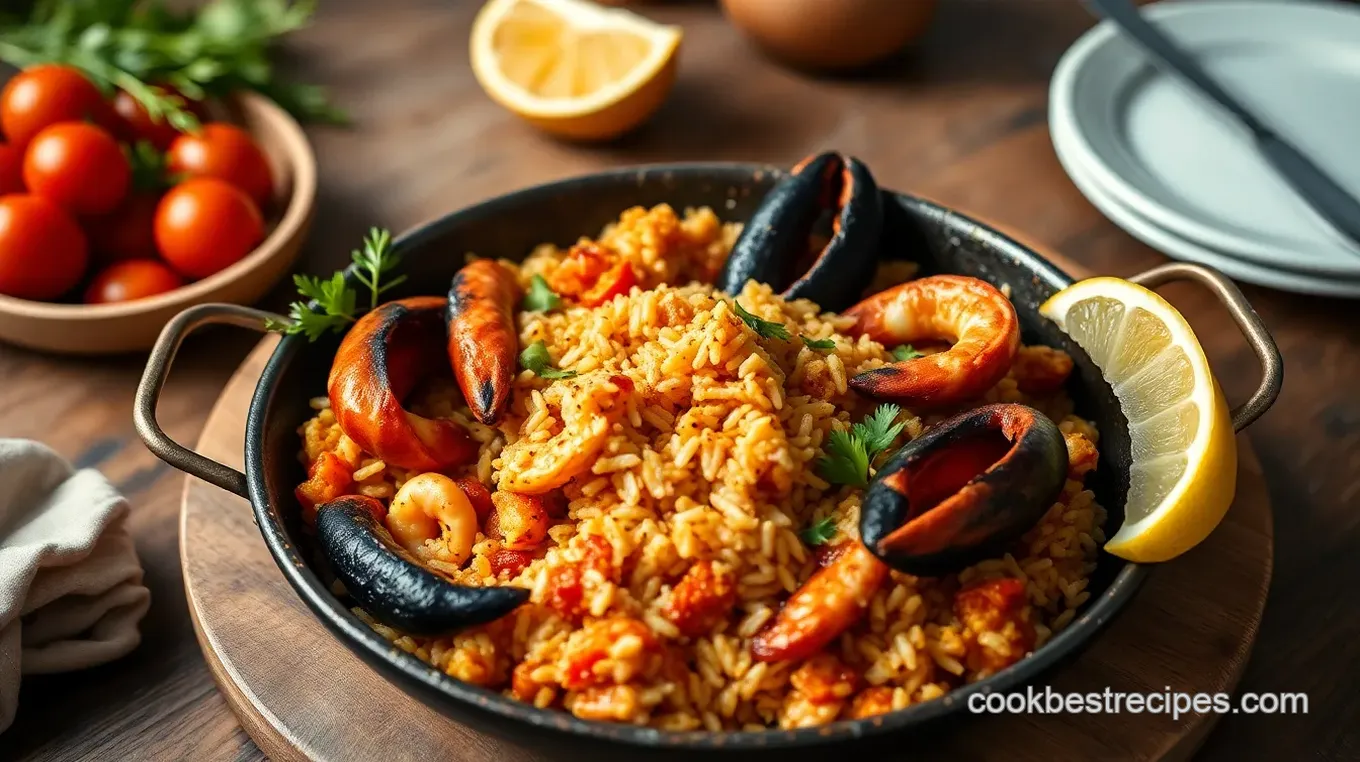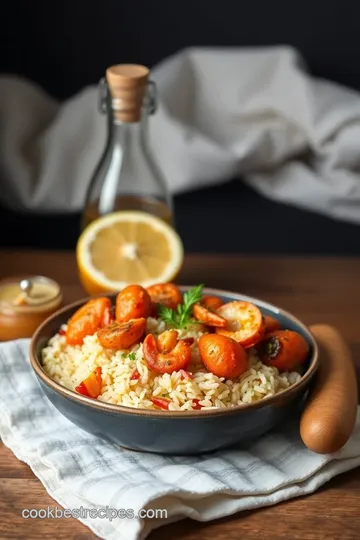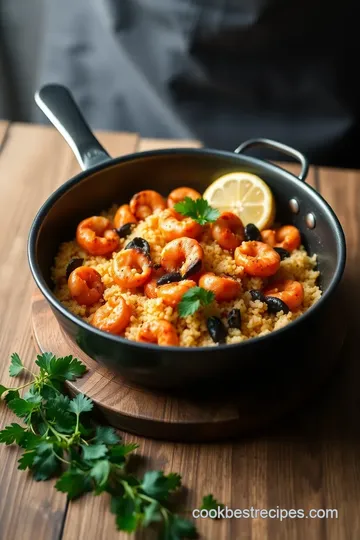Cooked Paella with Rice & Seafood Delight
Craving a taste of Spain? My Cooked Paella with Rice & Seafood Delight brings vibrant flavors to your kitchen. Here are tips for perfecting this enchanting dish!

look into into the World of Cooked Paella with Rice & Seafood Delight
Oh my gosh! let me take you back to the very first time i tried cooked paella with rice & seafood delight .
It was at a summer block party, and i could smell that incredible aroma wafting through the air. as soon as i took a bite, i was hooked! the layers of flavor and textures reminded me of the breezy beaches of valencia, where this dish originated.
It made me wonder—what is it about seafood and rice that creates such pure magic in a dish? let’s dive into this delicious journey together!
A Taste of History: The Magic of Paella
So, where did this spanish paella recipe come from? let’s rewind a bit. originating from the sun-kissed shores of valencia, paella dates back to the mid-19th century.
It became a beloved dish among locals who gathered to celebrate the harvest, cooking it over an open fire. fast forward to today, and this saffron rice dish is celebrated worldwide! each region seems to have its own twist—like valencia-style paella , which features rabbit and snails.
But don't worry; our focus is on the seafood goodness that brings the incredible coastal vibe right to your dinner table.
Now, you might be wondering, "is it a hassle to make?" honestly, not at all! the recipe sits somewhere in the medium range.
You’ll need about 60 minutes in total, with 20 minutes for prep and around 35- 40 minutes of cooking time.
And hey, it serves up to four generous portions , so it’s perfect for sharing. just a heads up—quality seafood can bump the cost up a notch, but trust me, it’s totally worth it for that fresh flavor explosion!
Why You’ll Love This Recipe: The Key Benefits
Now let’s chat about the many benefits of cooking this stunning rice and seafood dish . first off, let’s talk about health! did you know that seafood is packed with omega-3 fatty acids? these are great for your heart and brain health.
Plus, the colorful veggies in this dish bring in those essential vitamins.
You can also show off your culinary skills! when you serve this dish at gatherings or special occasions, everyone will gather around to ooh and aah over the beautiful presentation.
And speaking of gatherings, there’s just something about sharing paella cooking instructions with friends that makes it a memorable experience.
You’ll all get in on the action, and trust me, the laughter and camaraderie that come with cooking it together is half the fun!
As for its unique selling points , you can easily tweak the recipe to suit your taste. whether you want to add a bit of chorizo for depth of flavor or decide to go full-on veggie for a meat-free option, the possibilities are endless.
Trust me, getting creative with paella variations is part of the joy!
Ready to get your hands on the recipe? it’s time to gather those traditional paella ingredients and start cooking! here’s what you need before you can dig into that gorgeous plate of cooked paella with rice & seafood delight .
I can't wait to share the ingredients next, but i promise, once you taste those heavenly flavors, this dish will quickly become part of your culinary repertoire.
So what are you waiting for? let’s cook!

Essential Ingredients Guide to Cooked Paella with Rice & Seafood Delight
If you're diving into the world of spanish paella recipes , it’s super important to have the right ingredients on hand.
Let’s break it down. getting these essentials means you’re on your way to a stunning dish that’ll have everyone saying “¡olé!”
Premium Core Components
Starting with measurements , here’s the scoop:
- 1 ½ cups (300g) of Bomba or Arborio rice
- 3 cups (720ml) of low-sodium chicken or fish broth
- 1/2 cup (120ml) of dry white wine
- 1/4 tsp of saffron threads (totally optional but oh-so-recommendable)!
When we’re talking quality indicators , pick a rice that’s plump and has a slight sheen. it should feel a little sticky to the touch.
For broth, homemade is best (hey, you can freeze it for later!), but low-sodium storebought works too. as for the saffron ? grab the good stuff! that bright color makes for an amazing saffron rice dish that screams authenticity.
Now let’s chat about storage . keep your rice in a cool, dry place—that should keep it fresh for up to 1-2 years .
Broth can last in the fridge for about a week or you can freeze it for up to 3 months .
Freshness tips? always check the color and aroma of your seafood—if it doesn't smell like the ocean, pass!
Signature Seasoning Blend
Creating the perfect signature seasoning blend takes a good sprinkle of herbs and spices. a classic mix for your paella includes paprika, cumin, and some fresh parsley .
While cumin has a warm earthiness, paprika adds a smoky flavor we all love. and don’t forget the garlic —it’s a must!
When you pick your herbs , basil and thyme work wonders as well. depending on where you’re at, you might want a little oregano too for that mediterranean touch.
Offering regional variations ? absolutely! if you’re feeling adventurous, try a splash of harissa for a moroccan twist or even tarragon for something different!
Smart Substitutions
Sometimes you may have to get a bit creative—no biggie! if you can’t find bomba rice, arborio will do. there’s no shame in making smart common alternatives .
Other substitutions like quinoa or orzo can also work, especially if you want to shake things up in your rice and seafood dish .
Dietary restrictions? A veggie paella with seasonal veggies like zucchini and artichokes is totally an option. And hey, if you’re in a pinch, canned seafood can work too—just rinse it first!
Kitchen Equipment Essentials
Alright, let’s talk equipment! Here’s the kitchen gear you’ll need :
- A large paella pan or a wide skillet (if you wanna get fancy, go for the traditional paella pan).
- A ladle for your broth—seriously, this saves so much mess!
- A measuring cup and spoons (no guessing! We want precision).
If you don’t have a paella pan, a cast-iron skillet works like a charm too. when it comes to storage , try using glass containers.
They keep your fresh ingredients swanked up and ready to rock!
Words to the Wise
Here’s a little nugget of wisdom— don’t stir your rice once you add the broth. this helps form that precious socarrat , the crispy base that paella lovers crave.
Patience, my friends, is key here.
And guess what? Whether you’re hosting a fiesta or just treating yourself on a mid-week Tuesday, Cooked Paella with Rice & Seafood Delight is your ticket to an Italian vacation!
Next up, we’ll get into the nitty-gritty with some cooking instructions —because once you’ve got your ingredients prepped, it’s time to put on your chef hat!
Professional Cooking Method: Mastering Cooked Paella with Rice & Seafood Delight
If you want to impress your friends and family, serving up a cooked paella with rice & seafood delight is a surefire way to win hearts and stomachs.
Now, i know what you might be thinking: “cooking a perfect paella sounds complicated!” but don’t worry—i'm here to simplify it and share some straightforward professional cooking methods along the way.
Essential Preparation Steps
First things first— mise en place . this fancy french term just means getting everything in its place. chop your veggies, measure your rice, and gather your seafood before you even think about turning on the stove.
It makes the cooking process so much smoother. i can't tell you how many times i’ve been caught mid-cooking with a forgotten ingredient.
It’s like playing hide and seek in the kitchen, and trust me, you never want to find a missing onion when it’s too late!
Time management is another vital part. set timers while you prep and cook, especially when you get to that 15-20 minute simmer time for the rice.
Make sure to keep an eye on the clock. nothing is worse than undercooked rice, or yikes, burnt seafood! also, organize your workspace! having a clutter-free area keeps your mind clear—this is your culinary playground after all.
Safety first, amigos! when working with seafood, you gotta keep it fresh. always check for weird smells, and don’t forget to wash your hands after handling raw seafood.
Food safety isn’t just a suggestion—it’s a necessity!
Step-by-Step Process
Here’s how you can nail that paella with clear, numbered instructions :
-
Prepare the Broth: Heat 3 cups of fish broth in a saucepan. Infuse with 1/4 tsp of saffron . Keep it warm.
-
Sauté the aromatics: in your paella pan, heat 1/4 cup of olive oil over medium heat. add 1 chopped onion and cook for about 5 minutes until it’s translucent.
Then toss in 3 minced garlic cloves and 1 diced red bell pepper . cook for 2-3 more minutes.
-
Add the Rice: Stir in 1 ½ cups of Bomba rice and toast it for about 2 minutes . This adds some extra flavor.
-
Deglaze: Pour in 1/2 cup of dry white wine and stir until it’s mostly gone.
-
Combine with Broth: Pour in the warm broth along with 1 cup of halved cherry tomatoes and 1 cup of frozen peas . Bring it up to a gentle boil.
-
Layer the Seafood: Spread ½ lb of shrimp , ½ lb of mussels , and ½ lb of squid over the top. Resist the urge to stir!
-
Cook the Paella: Lower the heat and let it simmer uncovered for 15- 20 minutes . That rice needs to soak in all those delicious flavors.
-
Create the Socarrat: For that delightful crispy bottom, crank up the heat for the last 2- 3 minutes . You’ll hear that satisfying crackling—just be careful not to burn it!
-
Rest and Garnish: Cover your paella with a clean cloth for 5 minutes . Garnish with fresh parsley and lemon wedges when serving.
Expert Techniques
You’ll want to use quality seafood —it’s all about those flavors! the best seafood for paella includes shrimp, mussels, and squid, all of which bring a lovely brininess to the dish.
Pay attention during cooking; timing is everything!
Don’t forget about the socarrat—this is the holy grail of paella lovers! it’s that signature crispy bottom. if it burns a bit, just call it 'extra charred' and move on! but really, to avoid disaster, stick to a medium heat and watch like a hawk.
Success Strategies
Let’s talk common mistakes. overcooking seafood is one of them. keep your timing precise. also, don’t stir it once you add the broth! you gotta let those flavors meld together.
Quality assurance is key—taste before serving! a splash of lemon can brighten things up.
And if you’re short on time? Make-ahead options are a lifesaver! Pair your easy paella recipe with some mediterranean sides , and you have a feast ready to go.
In spanish culinary culture, gathering around paella is a tradition. so, next time you make this delightful dish, i encourage you to gather your loved ones, share stories, and just enjoy the experience.
Additional Information...
Ready to dive deeper into your spanish cooking adventures? stay tuned for more authentic recipes that highlight the unique flavors of this vibrant cuisine! whether you want to know more about traditional paella ingredients or cooking techniques, i've got you covered.

Pro Tips & Secrets for Cooking the Perfect Paella
Okay, let’s get real for a second. when i first tried making cooked paella with rice & seafood delight , i felt like i was stepping into the realm of culinary giants.
But trust me, it’s not all that daunting! here are some juicy chef’s secrets and time-saving techniques i’ve picked up along the way that will make your paella pop.
Mastering the Paella
First off, use quality seafood . you know what i mean—fresh shrimp, mussels, and squid. they make a world of difference.
If you can, hit up your local fish market for the best seafood for paella . also, don’t skimp on the saffron ! it’s the secret ingredient in that saffron rice dish that’ll have your friends raving.
Timing is key, right? if you’re wondering how to make paella that’s not mushy, resist the urge to stir once you add in the broth.
Seriously! just let it simmer and soak up all those flavors like a sponge.
Perfect Presentation
Let’s chat about making it look as good as it tastes. plating techniques matter! i love using a large, wide paella pan for that classic look.
You don't need to be a food stylist; just spread out the ingredients so they shine. think color : vibrant reds from the bell peppers, greens from the peas, and the stunning oranges from the saffron.
For garnishing, fresh parsley adds a nice touch, and a sprinkle of lemon zest brings brightness. if you wanna take it up a notch, throw in some lemon wedges on the side.
Trust me, your cooked paella serving suggestions will leave everyone drooling!
Storage & Make-Ahead
Speaking of drool, if you’ve got leftovers—lucky you! store your paella in an airtight container in the fridge. it’ll last about 2-3 days.
When you reheat it, add a splash of broth to keep it from drying out. and don’t be shy to toss it in the microwave for a quick seafood meal.
Planning ahead? you can prep most of the ingredients a day before. chop those veggies, clean that seafood, and whip up your broth.
You’ll be set to impress at dinner parties without running around like a headless chicken.
Creative Variations
Alright, here’s some fun! feeling adventurous? try paella variations —you can easily swap in seasonal veggies for those times when the farmers market is bursting with color.
Think autumn squash or spring onions . or for those cozy winter days, a hearty addition of chorizo could kick things up a notch.
Don’t forget the different diets out there! If you're accommodating someone, consider a veggie version. Just load it with a rainbow of vegetables and keep the saffron and broth.
Complete Nutrition Guide
While we’re diving into deliciousness, let’s take a peek at the health aspects. your cooked paella with rice & seafood delight isn’t just tasty; it’s also packed with nutrients.
Each serving provides lean protein from the seafood and carbs from the rice, making it a balanced meal.
Seafood boasts those health benefits we all need—like omega-3 fatty acids. So, if you're looking for a one-pot seafood meal that’s as health-conscious as it is hearty, this recipe has your back!
Expert FAQ Solutions
Now, i know you’ve got questions, and that’s perfectly normal. common concerns often revolve around cooking times or ingredient swaps.
For those who struggle with that perfect socarrat —the crispy layer at the bottom—just crank up the heat for the last few minutes while listening for that sizzling music.
It’s your tell-tale sign of success!
Got leftover seafood? Yes, you can mix it with some of your favorite garden-fresh produce for a quick dish tomorrow to use those extra ingredients.
Wrapping It Up
Cooking cooked paella with rice & seafood delight is all about the experience and the joy of sharing a meal with loved ones.
Whether you're whipping it up for friends or just for yourself, the flavors will transport you right to the beaches of valencia.
Embrace the culinary challenges and make it your own. so grab that paella pan and gather around! your taste buds are in for an adventure.
Happy cooking, my friends!

Cooked Paella with Rice & Seafood Delight Card

⚖️ Ingredients:
- 1 ½ cups (300g) Bomba or Arborio rice
- 3 cups (720ml) low-sodium chicken or fish broth
- 1/2 cup (120ml) dry white wine
- 1/4 tsp saffron threads
- 1 medium onion, finely chopped
- 3 cloves garlic, minced
- 1 red bell pepper, diced
- 1 cup (150g) cherry tomatoes, halved
- 1 cup (150g) frozen peas
- ½ lb (225g) raw shrimp, peeled and deveined
- ½ lb (225g) mussels, cleaned and debearded
- ½ lb (225g) squid, cleaned and cut into rings
- 1/4 cup (60ml) olive oil
- Salt and pepper, to taste
- Fresh parsley, for garnish
- Lemon wedges, for serving
🥄 Instructions:
- Step 1: Heat the broth in a saucepan and infuse with saffron. Simmer gently to keep warm.
- Step 2: In the paella pan, heat olive oil over medium heat. Add onion and cook until translucent (about 5 minutes). Stir in garlic and red bell pepper; cook for another 2-3 minutes.
- Step 3: Stir in the rice, ensuring it is coated with oil. Toast briefly (about 2 minutes).
- Step 4: Pour in white wine, stirring until almost evaporated.
- Step 5: Carefully pour in the warm saffron-infused broth. Season with salt and pepper. Add cherry tomatoes and peas. Bring to a gentle boil.
- Step 6: Arrange shrimp, mussels, and squid evenly over the surface. Do not stir once the seafood is added.
- Step 7: Reduce heat to low and simmer uncovered (about 15-20 minutes) until the rice absorbs the broth and becomes tender.
- Step 8: Increase heat for the last 2-3 minutes to form a crispy layer on the bottom (listen for a crackling sound).
- Step 9: Remove from heat and cover with a clean cloth for 5 minutes. Garnish with parsley and serve with lemon wedges.
Previous Recipe: How to Bake Elbow Macaroni with Creamy Cheese: A Delicious Comfort
Next Recipe: How to Bake Peach Cobbler with Buttery Crust: A Delicious Family Treat
